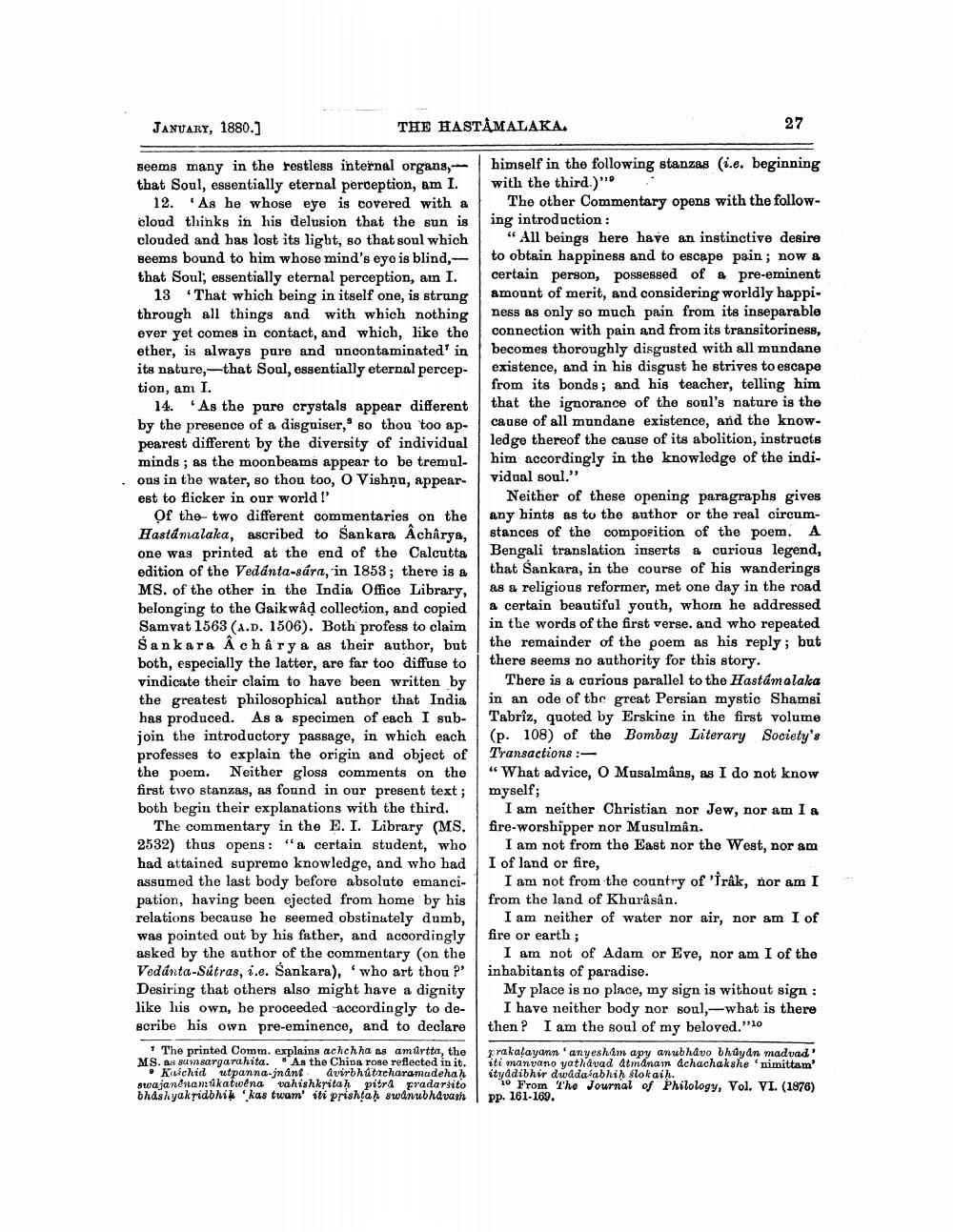________________
JANUARY, 1880.]
THE HASTAMALAKA.
27
seems many in the restless internal organs, himself in the following stanzas (i.e. beginning that Soul, essentially eternal perception, am I. with the third.)"
12. "As he whose eye is covered with a The other Commentary opens with the followcloud thinks in his delusion that the sun is ing introduction: clouded and has lost its light, so that soul which "All beings here have an instinctive desire Beems bound to him whose mind's eye is blind, - to obtain happiness and to escape pain; now & that Soul; essentially eternal perception, am I.
certain person, possessed of a pre-eminent 13 "That which being in itself one, is strung
amount of merit, and considering worldly happithrough all things and with which nothing ness as only so much pain from its inseparable ever yet comes in contact, and which, like the connection with pain and from its transitoriness, ether, is always pure and uncontaminated in becomes thoroughly disgusted with all mundane its nature, that Soul, essentially eternal percep
existence, and in his disgust he strives to escape tion, am I.
from its bonds; and his teacher, telling him 14. As the pure crystals appear different that the ignorance of the soul's nature is the by the presence of a disguiser, so thou too ap
cause of all mundane existence, and the knowpearest different by the diversity of individual ledge thereof the cause of its abolition, instructe minds; as the moonbeams appear to be tremul
him accordingly in the knowledge of the indions in the water, so thou too, O Vishnu, appear. vidual soul." est to flicker in our world!
Neither of these opening paragraphs gives of the two different commentaries on the any hints as to the author or the real circumHastamalaka, ascribed to Sankara Acharya, stances of the composition of the poem. A one was printed at the end of the Calcutta Bengali translation inserts a curious legend, edition of the Vedanta-sára, in 1859; there is a that Sankara, in the course of his wanderings MS. of the other in the India Office Library, as a religious reformer, met one day in the road belonging to the Gaikwad collection, and copied a certain beautiful youth, whom he addressed Samvat 1563 (a.D. 1506). Both profess to claim in the words of the first verse, and who repeated Sankara Acharya as their author, but the remainder of the poem as his reply; but both, especially the latter, are far too diffuse to there seems no authority for this story. vindicate their claim to have been written by There is a curious parallel to the Hastamalaka the greatest philosophical author that India in an ode of the great Persian mystic Shamsi has produced. As a specimen of each I sub- Tabriz, quoted by Erskine in the first volume join the introductory passage, in which each (p. 108) of the Bombay Literary Society's professes to explain the origin and object of Transactions :the poem. Neither gloss comments on the “What advice, O Musalmans, as I do not know first two stanzas, as found in our present text; | myself; both begin their explanations with the third. I am neither Christian nor Jew, nor am I a
The commentary in the E. I. Library (MS. fire-worshipper nor Musulman. 2532) thus opens : "a certain student, who I am not from the East nor the West, nor am had attained supremo knowledge, and who had I of land or fire, assumed the last body before absolute emanci- 1 I am not from the country of 'Irak, nor am I pation, having been ejected from home by his from the land of Khurâsân. relations because he seemed obstinutely dumb, | I am neither of water nor air, nor am I of was pointed out by his father, and accordingly fire or earth; asked by the author of the commentary (on the I am not of Adam or Eve, nor am I of the Vedanta-Sátras, i.e. Sankara), who art thou ?' inhabitants of paradise. Desiring that others also might have a dignity My place is no place, my sign is without sign: like his own, he proceeded accordingly to de- I have neither body nor soul, what is there scribe his own pre-eminence, and to declare | then? I am the soul of my beloved."10
The printed Comm. explains achchha as am drtta, the | prakalayann anyesham apy anubhavo bhayan madvad! MS. As sumsargardhita. "As the Chipa rose reflected in it. iti manvano yathavad dtmdnam dchachakshe nimittam
Kiichidupanna.jnant dvirbh atacharamadehah ityddibhir dwada kabhih Slokaih. swajandnamakatuena vahishkritaḥ pitra pradarsito 1o From The Journal of Philology, Vol. VI. (1876) bhashyakridbhi kas twum' iti prishtah swanubhavam
swanaondoanh Pp. 161-169.




